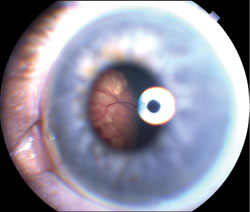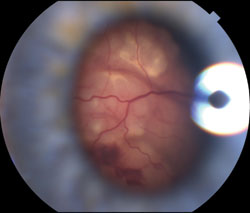Man referred for acute decrease in vision
The patient was found to have a choroidal mass.
Click Here to Manage Email Alerts
 Priti Batta |
 Namrata Nandakumar |
A 59-year-old man was referred to our practice for evaluation of decreased vision in the left eye for the past 5 days. He noted flashes of light and a curtain in the superior hemisphere of his vision. There was no history of trauma.
His medical history was significant for hypertension and hypercholesterolemia. His medications included simvastatin and hydrochlorothiazide. His past ocular history was significant for presbyopia. He had no family history of ocular disease. He denied smoking, drinking or illicit drug use.
Examination
On examination, the patient’s best corrected visual acuity was 20/30 in the right eye and 20/25 in the left. His pupils were reactive with no afferent pupillary defect. Confrontational visual fields showed a superior deficit in his left eye. His color vision with Ishihara color plates was full in both eyes. His IOP was 16 mm Hg in the right eye and 12 mm Hg in the left. Extraocular motility appeared full in both eyes.
|
|
|
|
Figure 1. Amelanotic mass was visible through
the pupil in the left eye.
Images: Nandakumar N, Duker
JS |
|
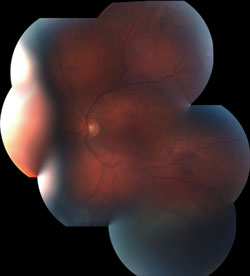 Figure 2. Choroidal mass and an inferior exudative retinal detachment in the left eye. |
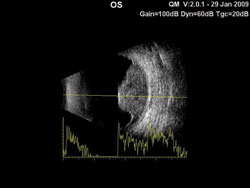 Figure 3. B- scan demonstrated a 9.4-mm elevated choroidal lesion that was sonolucent. |
Anterior segment examination showed mild nuclear sclerotic cataracts in both eyes and trace vitreal cells in the left eye. Through a dilated pupil, an amelanotic mass was visible nasally in the left eye (Figure 1). Posterior segment examination was normal in the right eye. Posterior segment examination of the left eye showed a healthy-appearing nerve and a normal-appearing macula. Inferonasally, there was an elevated amelanotic choroidal lesion with hemorrhage over the surface of the mass. There was also an exudative retinal detachment inferiorly (Figure 2).
B-scan ultrasonography (Figure 3) demonstrated a 9.4-mm solid, dome-shaped elevated choroidal lesion that was acoustically dark. A-scan ultrasonography demonstrated low-amplitude internal reflectivity. Fluorescein angiography initially showed a few large intralesional vessels, with filling of both retinal and intralesional vessels in the early phase frames. There was progressive leakage from the intralesional vessels, and late phase frames showed intense staining of the lesion. Indocyanine green angiography was performed and the lesion appeared relatively hypofluorescent throughout the study.

What is your diagnosis?
Elevated choroidal lesion with an exudative retinal detachment
The differential diagnosis of exudative retinal detachments is large and includes: neoplastic processes such as choroidal melanomas and choroidal metastases; inflammatory processes such as Vogt-Koyanagi-Harada syndrome, sympathetic ophthalmia, posterior scleritis and vasculitic entities such as rheumatoid arthritis; congenital causes such as optic pits and colobomas; idiopathic processes such as Coats’ disease, central serous chorioretinopathy and uveal effusion syndrome; and vascular processes such as exudative macular degeneration.
Given our patient’s history, exam and ancillary tests, a neoplastic process such as choroidal metastasis, choroidal hemangioma or choroidal melanoma is most likely.
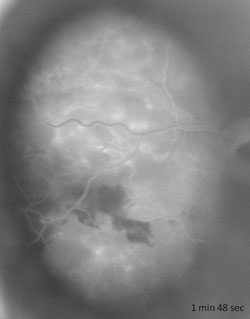 Figure 4. Fluorescein angiography classically shows large caliber intralesional vessels and a dual circulation. |
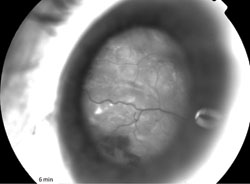 Figure 5. ICG was performed and the lesion appeared relatively hypofluorescent. |
Due to its extensive blood supply, metastatic intraocular lesions are most often located in the choroid. The most common cancer to metastasize in women is breast cancer, and in men it is lung cancer. Choroidal metastases are sonoreflective on B-Scan. An A-scan shows high or medium internal reflectivity. Fluorescein angiography demonstrates few or no large caliber vessels.
Choroidal hemangiomas are round orange-red lesions comprising blood vessels that grow within the choroid. They do not metastasize. Localized choroidal hemangiomas are generally diagnosed based on their funduscopic appearance. They can have different degrees of retinal pigment epithelial degeneration and can have subretinal fluid, making them hard to differentiate from choroidal melanomas. On B-scan, circumscribed choroidal hemangiomas have a solid acoustic appearance. A-scan ultrasonography has characteristically high internal reflectivity. The fluorescein angiogram demonstrates early hyperfluoresence in the choroidal or early arterial phase, with progressive hyperfluoresence of the lesion.
Choroidal melanomas appear acoustically dark on B-scan. An A-scan typically demonstrates medium- to low-amplitude internal reflectivity. As seen in our patient, fluorescein angiography classically shows large caliber intralesional vessels and a dual circulation.
Diagnosis and management
Based on our patient’s history and examination, a diagnosis of a choroidal melanoma was made. Choroidal melanomas are the most common primary malignant intraocular tumors. The incidence in the U.S. is six cases per 1 million. They arise from melanocytes in the choroid and can range from being pigmented to amelanotic. They can be dome-shaped or, if they break through the retinal pigment epithelium, can take on a mushroom configuration. Choroidal melanomas cause death due to distant metastasis. The most common site of metastasis is the liver. Overall, the mortality rate is 30% to 35% within 10 years of diagnosis and treatment. Treatment options include radiation therapy, photocoagulation or cryotherapy, photodynamic therapy, enucleation or exenteration, and observation.
Based on the size and location of the lesion, our patient underwent plaque therapy. His physical exam, blood work including liver function tests, and CT scan were within normal limits. He continues to be followed closely in our clinic.
References:
- Albert DM, Wagoner MD, Smith ME. Are metastatic evaluations indicated before enucleation of ocular melanoma? Am J Ophthalmol. 1980;90(3):429-432.
- Augsburger JJ, Corrêa ZM, Freire J, Brady LW. Long-term survival in choroidal and ciliary body melanoma after enucleation versus plaque radiation therapy. Ophthalmol. 1998;105(9):1670-1678.
- Diener-West M, Earle JD, Fine SL, et al. The COMS randomized trial of iodine 125 brachytherapy for choroidal melanoma, III: initial mortality findings. COMS Report No. 18. Arch Ophthalmol. 2001;119(7):969-982.
- Egan KM, Seddon JM, Glynn RJ, Gragoudas ES, Albert DM. Epidemiologic aspects of uveal melanoma. Surv Ophthalmol. 1988;32(4):239-251.
- Rankin SJ, Johnston PB. Metastatic disease from untreated choroidal and ciliary body melanomas. Int Ophthalmol. 1991;15(2):75-78.
- Sallet G, Amoaku WM, Lafaut BA, Brabant P, De Laey JJ. Indocyanine green angiography of choroidal tumors. Graefes Arch Clin Exp Ophthalmol. 1995;233(11):677-689.
- Shields JA, Rodrigues MM, Sarin LK, et al. Lipofuscin pigment over benign and malignant choroidal tumors. Trans Sect Ophthalmol Am Acad Ophthalmol Otolaryngol. 1976;81(5):871-881.
- Sisley K, Rennie IG, Parsons MA, et al: Abnormalities of chromosomes 3 and 8 in posterior uveal melanoma correlate with prognosis. Genes Chromosomes Cancer. 1997;19(1):22-28.
- Sobottka B, Schlote T, Krumpaszky HG, Kreissig I. Choroidal metastases and choroidal melanomas: comparison of ultrasonographic findings. Br J Ophthalmol. 1998;82(2):159-161.
- Namrata Nandakumar, MD, and Jay S. Duker, MD, can be reached at New England Eye Center, Tufts University School of Medicine, 750 Washington St., Box 450, Boston, MA 02111; 617-636-4219; fax: 617-636-4866; website: www.neec.com.
- Edited by Priti Batta, MD, and Namrata Nandakumar, MD. Drs. Batta and Nandakumar can be reached at New England Eye Center, Tufts University School of Medicine, 750 Washington St., Box 450, Boston, MA 02111; 617-636-4219; fax: 617-636-4866; website: www.neec.com.

